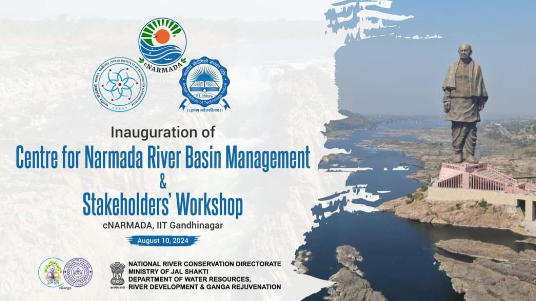IIT Gandhinagar and IIT Indore Launch cNARMADA for Narmada River Basin Management (GS Paper 2, Government Initiatives)

Introduction
- On August 12, 2024, the Indian Institute of Technology Gandhinagar (IITGN) and IIT Indore launched a groundbreaking initiative called the Centre for Narmada River Basin Management (cNARMADA).
- This new center, supported by the Ministry of Jalshakti, is dedicated to tackling the environmental and ecological challenges faced by the Narmada River and its basin, aiming to foster sustainable management practices for this vital water resource.
Purpose of cNARMADA
The primary goal of cNARMADA is to conduct an in-depth evaluation of the Narmada River’s ecosystem. The center’s mission is to:
- Assess Ecosystem Health: Evaluate the current state of the Narmada River and its tributaries.
- Identify Problems: Identify the key environmental issues affecting the river’s health and biodiversity.
- Develop Solutions: Propose and implement strategies to address these issues and promote long-term sustainability of the river’s ecosystem.
By focusing on these objectives, cNARMADA aims to enhance understanding of the river’s environmental status and devise effective management plans to safeguard its future.
Assessment Process: Condition Assessment and Management Plan (CAMP)
To achieve its objectives, cNARMADA will employ the Condition Assessment and Management Plan (CAMP), which involves:
- Comprehensive Study: Conducting a thorough examination of the Narmada River and its smaller tributaries.
- Impact Analysis: Assessing how human activities—ranging from industrial processes to urban expansion—affect the river’s health and the surrounding environment.
Key Components of CAMP:
- Field Surveys and Data Collection: Collecting data on water quality, flora, fauna, and land use.
- Environmental Impact Analysis: Analyzing how different human activities such as industrialization, urbanization, and deforestation impact the river and its ecosystem.
- Stakeholder Engagement: Collaborating with local communities, industries, and government agencies to gather insights and develop comprehensive management strategies.
Key Areas of Study
The CAMP will focus on several critical aspects that influence the health of the Narmada River:
- Industrial Activities: Examining the pollution and ecological disruption caused by industrial operations along the river.
- Urbanization: Assessing the effects of city and town expansion on river ecosystems, including increased runoff and habitat loss.
- Lifestyle Changes: Investigating how changes in local lifestyles, including consumption patterns and waste management practices, affect the river.
- Agricultural Practices: Analyzing the impact of farming activities, including pesticide use and soil erosion, on river water quality.
- Deforestation: Evaluating the consequences of forest loss on river catchment areas, including reduced water retention and increased soil erosion.
- Infrastructure Development: Reviewing the impacts of dam construction, flood control measures, and other infrastructural developments on the river’s flow and ecosystem.
Facts About the Narmada River Basin
- Geographical Scope: The Narmada River flows through Madhya Pradesh, Maharashtra, and Gujarat, covering a basin area of approximately 97,000 square kilometers.
- Economic Importance: The river is crucial for irrigation, drinking water supply, and hydroelectric power generation. It supports extensive agricultural activities and provides water to major cities and towns in its basin.
- Sardar Sarovar Dam: One of Asia’s largest dams, the Sardar Sarovar Dam, is located on the Narmada River, playing a key role in water management and power generation.
- Cultural Significance: The Narmada River holds religious importance, with numerous temples and sacred sites along its banks. It is considered a holy river in Hinduism.
- Environmental Challenges: The river faces significant issues such as deforestation, pollution from industrial and domestic sources, and habitat degradation. These challenges threaten the river’s biodiversity and the livelihoods of millions of people who depend on it.
- Human Dependence: The river basin supports the livelihoods of approximately 1.5 million people who rely on its resources for their daily needs.
Facts About the Ministry of Jalshakti
- Formation: Established in 2019, the Ministry of Jalshakti oversees water resource management and sanitation in India.
- Merger: The ministry was created by merging the Ministry of Water Resources, River Development and Ganga Rejuvenation, with the Ministry of Drinking Water and Sanitation.
- Responsibilities: Manages major programs such as the National River Conservation Plan and the Namami Gange Programme, focusing on the conservation and rejuvenation of rivers.
- Mission: Plays a central role in the Swachh Bharat Mission, emphasizing water conservation, rainwater harvesting, and the interlinking of rivers to address water scarcity and promote sustainable development.
Conclusion
- The establishment of cNARMADA marks a significant advancement in managing the environmental challenges of the Narmada River basin.
- By implementing the Condition Assessment and Management Plan (CAMP), IIT Gandhinagar and IIT Indore, with support from the Ministry of Jalshakti, aim to provide a detailed understanding of the river’s current state and develop effective strategies for its sustainable management.
- The initiative underscores the importance of collaborative efforts and scientific research in addressing complex environmental issues and ensuring the long-term health of crucial water resources.


